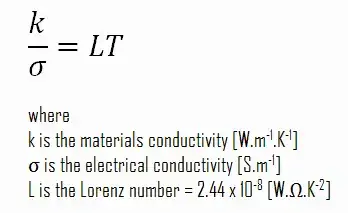Electrical and Thermal Conductivity
At a given temperature, the thermal and electrical conductivities of metals are proportional, but raising the temperature increases the thermal conductivity while decreasing the electrical conductivity. This behavior is quantified in the Wiedemann–Franz law. This law states that the ratio of the electronic contribution of the thermal conductivity (k) to the electrical conductivity (σ) of metal is proportional to the temperature (T).
Qualitatively, this relationship is based on the heat and electrical transport both involve the free electrons in the metal. The electrical conductivity decreases with particle velocity increases because the collisions divert the electrons from forwarding transport of charge. However, the thermal conductivity increases with the average particle velocity, increasing the forward transport of energy. The Wiedemann-Franz law is generally well obeyed at high temperatures. In the low and intermediate temperature regions, however, the law fails due to the inelastic scattering of the charge carriers.
It must be noted the general correlation between electrical and thermal conductance does not hold for other materials due to the increased importance of phonon carriers for heat in nonmetals.
Electrical Conductivity
Electrical conductivity is a physical property of materials that represents a material’s ability to conduct electric current. The SI unit of electrical conductivity is siemens per meter (S/m).
The electrical conductivity of a material is determined by several factors, including the density and mobility of charge carriers (such as electrons or ions), the structure of the material, temperature, and other environmental factors.
Materials with high electrical conductivity, such as metals and some types of salts and solutions, are commonly used in electrical and electronic applications, where they are used to carry electric current with minimal resistance or loss of energy. Other materials with low electrical conductivity, such as insulators and semiconductors, are used in applications where they can be used to control or manipulate the flow of electric charge.
Thermal Conductivity
The thermal conductivity of most liquids and solids varies with temperature, and for vapors, it also depends upon pressure. In general:
Metals are solids, and as such, they possess a crystalline structure where the ions (nuclei with their surrounding shells of core electrons) occupy translationally equivalent positions in the crystal lattice. Metals, in general, have high electrical conductivity, high thermal conductivity, and high density. Accordingly, transport of thermal energy may be due to two effects:
- the migration of free electrons
- lattice vibrational waves (phonons).



